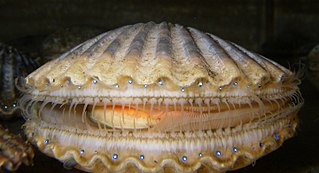
The Pteriomorphia comprise a subclass of saltwater clams, marine bivalve molluscs. It contains several major orders, including the Arcida, Ostreida, Pectinida, Limida, Mytilida, and Pteriida. It also contains some extinct and probably basal families, such as the Evyanidae, Colpomyidae, Bakevelliidae, Cassianellidae, and Lithiotidae.

Nuculidae is a family of small saltwater clams in the order Nuculida. Species in this family are commonly known as nut clams.

Anomalodesmata is an superorder of saltwater clams, marine bivalve molluscs. This grouping was formerly recognised as a taxonomic subclass. It is called a superorder in the current World Register of Marine Species, despite having no orders, to parallel it with sister taxon Imparidentia, which does have orders.

Isognomonidae is a family of medium-sized to large saltwater clams. They are pearl oysters, marine bivalve molluscs in the superfamily Pterioidea
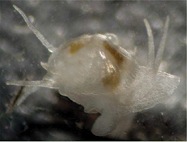
Galeommatidae is a family of small and very small saltwater clams, marine bivalve molluscs in the order Galeommatida.

Manzanellidae is a fossil family of bivalves, in the order Solemyida. They were previously considered containing fossil and recent members of Nucinellidae.
Hemidonax pictus is a species of bivalve in the family Hemidonacidae.

The giant honeycomb oyster is a very large saltwater oyster, a marine bivalve mollusk.

Hyotissa is a genus of large saltwater oysters, marine bivalve mollusks in the family Gryphaeidae.
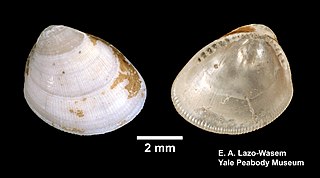
Nucula proxima, commonly known as the Atlantic nut clam, is a marine bivalve mollusc in the family Nuculidae. It can be found along the Atlantic coast of North America, ranging from Nova Scotia to Texas, including Bermuda.
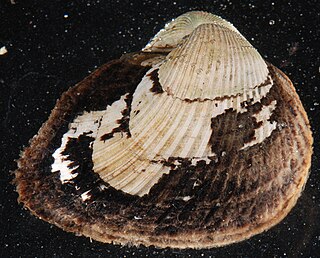
Noetia ponderosa, or the ponderous ark clam, is a marine clam in the family Noetiidae.

Polymesoda floridana, also known as the maritime marsh clam, is a species of bivalve mollusc in the family Cyrenidae.

Astarte borealis or Tridonta borealis, the boreal astarte, is a species of bivalve mollusc in the family Astartidae. It can be found in the Arctic Ocean and in the northern Pacific and Atlantic Oceans.
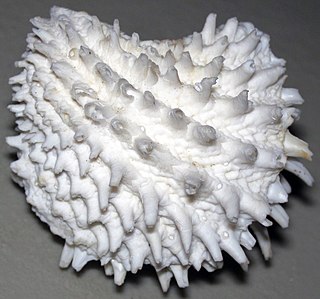
Arcinella cornuta, or the Florida spiny jewelbox clam or Florida spiny jewel box, is a marine species of bivalve mollusc in the family Chamidae. It can be found along the coast of North Carolina to Florida, Gulf of Mexico, Caribbean Central America, and Venezuela.

In May 2010, a new taxonomy of the Bivalvia was published in the journal Malacologia. The 2010 taxonomy is known as the Taxonomy of the Bivalvia . The 2010 taxonomy was published as Nomenclator of Bivalve Families with a Classification of Bivalve Families. This was a revised system for classifying bivalve mollusks such as clams, oysters, scallops, mussels and so on. In compiling this new taxonomy, the authors used a variety of phylogenetic information including molecular analysis, anatomical analysis, shell morphology and shell microstructure, as well as bio-geographic, paleobiogeographical and stratigraphic information.
Pinctada longisquamosa, sometimes called scaly pearl oysters, are a small species of pearl oyster found in the western Atlantic. They are distinguished by unique prismatic shell structures which protrude from the outer shell.
Rüdiger Bieler is a German-American biologist whose primary scientific field of study is malacology, the study of mollusks.

Cardites floridana, or the Broad-ribbed Carditid, is a marine clam in the family Carditidae. It can be found along the coasts of Florida, Central America, South America and the Gulf of Mexico.
Ennucula aegeensis, commonly known as the Aegean nut clam, is a nut clam present in the Atlantic Ocean, Gulf of Mexico, and the Mediterranean.
Galeommatoidea a superfamily of bivalves classified in the monotypic order Galeommatida.














